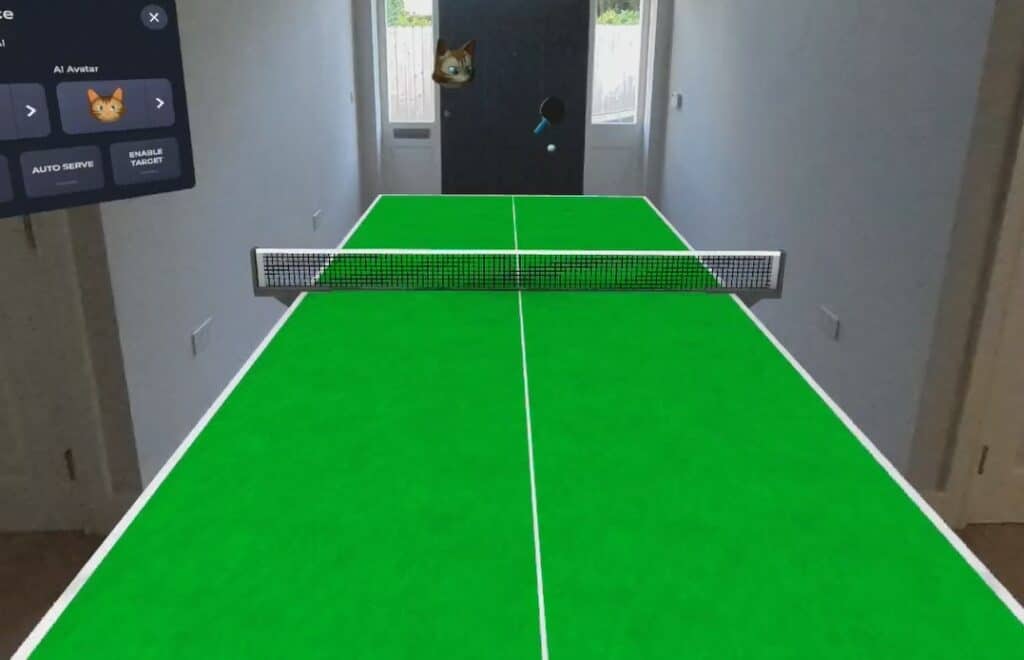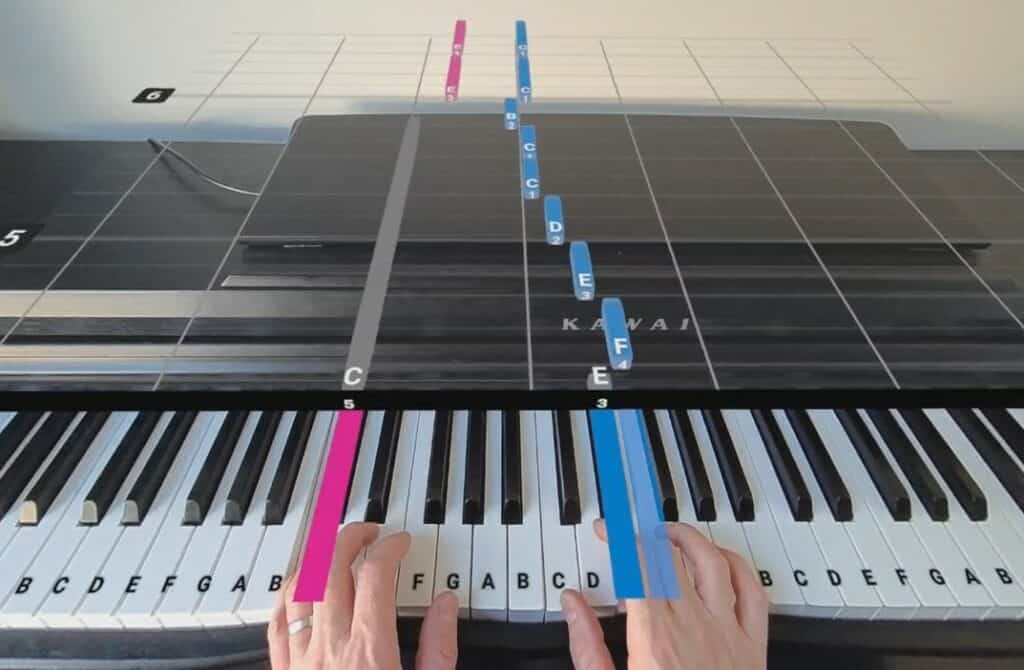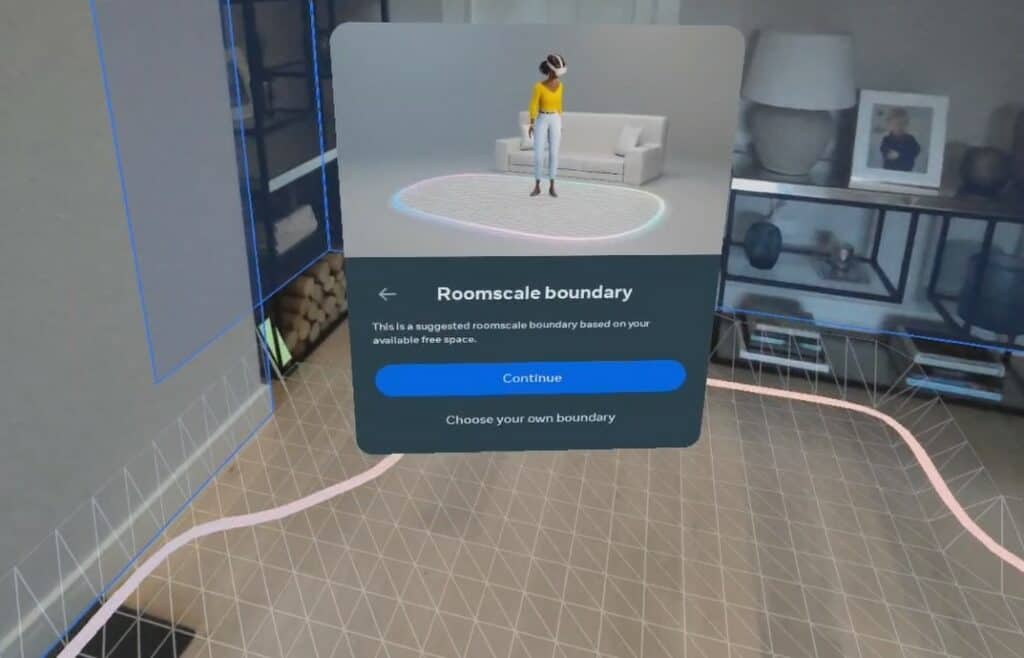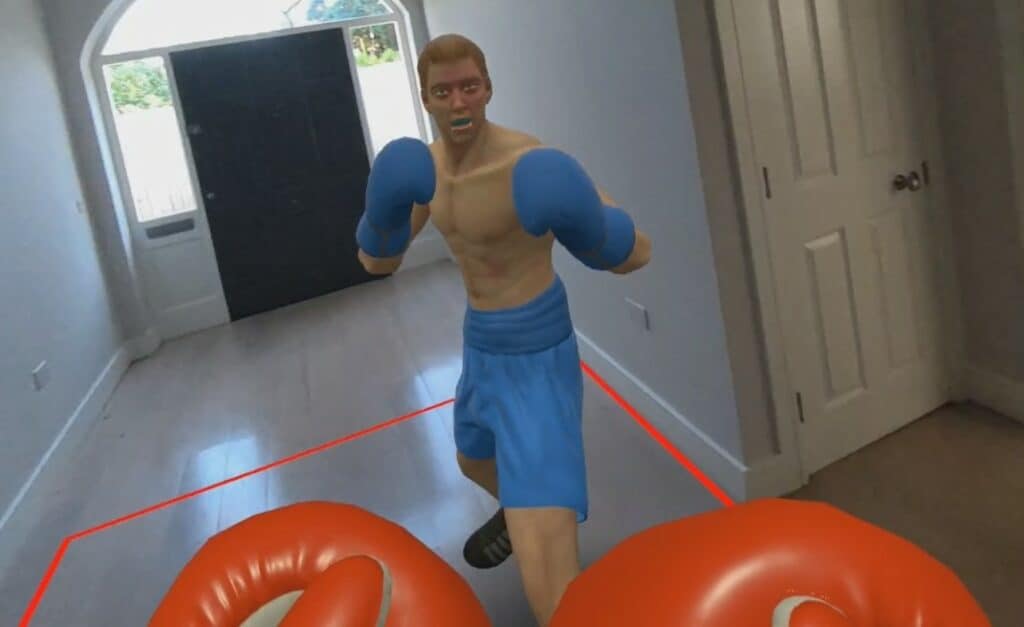
I’ve been testing the Meta Quest 3 intensely since it launched, putting in hundreds of hours with the headset. I was particularly keen to try out the mixed reality (MR) capabilities of Quest 3 as this is the first standalone headset with what I would consider to be acceptable mixed reality performance. Meta has been very enthusiastic about mixed reality on Quest 3 and this article is going to share my thoughts on how it stacks up.
Quest 3 has two front-facing 4MP RGB cameras and a depth sensor enabling you to put your headset on and see a passthrough image of the real world. The cameras are sufficiently good that you can walk around your room and interact with real objects without taking the headset off.
Mixed reality content is generally engaging and the use of depth sensor data to integrate features within your room into the game is an awesome feature. The passthrough image can be a little grainy in lower light conditions, and there is some distortion when you look at objects close up, but overall, it’s a big step up in quality from any other headset I have tried.
Is Mixed Reality On Meta Quest 3 Any Good?
Prior to purchasing Meta Quest 3, I had minimal expectations for what mixed reality could offer, but it has been one of the standout highlights of this new headset. Whilst I’ve been a VR enthusiast for years, appreciating the immersive environments that it allows you to experience, I underestimated the appeal of bringing virtual objects into the real world.
Having tested dozens of mixed reality games and experiences since the headset was launched, I am now of the opinion that it is mixed reality, rather than virtual reality content that is going to drive mass adoption of headsets over the next few years.
Being able to play games such as Eleven Table Tennis in my real world is both surreal and a ton of fun. I can place a virtual table anywhere in my real world and play table tennis against a virtual opponent, while still being able to see all of my real surroundings. This helps to make the experience less isolating from the real world and provides me with more confidence that I am not going to accidentally bump into furniture, or hit a wall with my controller.
The mixed reality experience feels much more seamless with reality than being cut off from the outside world in VR. Due to the quality of the passthrough cameras, if I need to get a drink or check my phone while playing, I can do this without taking the headset off. I can confidently walk around my house with the Quest 3 on, confident that I am not going to bump into anything, and then resume playing at any time.
There are multiple games now that integrate your real-world environment into the game. Games like Track Craft make use of the room scanning feature to allow you to drive a car over your real furniture as well as virtual objects, to complete a range of obstacle courses.
First Encounters lets you shoot parts of your real walls and ceiling away to reveal an alien landscape, as you zap alien blobs, in a wonderful introduction to MR that comes bundled with every Quest 3.
One of my favorites is PianoVision, which lets you overlay a virtual piano on top of the keys of a real one, allowing you to learn to play the piano with the aid of mixed-reality content that shows you what notes to play and when.
Just for fun, I’ve been able to pull up a virtual screen in my kitchen to show me a recipe that I can then prepare while wearing my headset. I’ve even positioned a virtual screen in front of my treadmill and gone for a quick jog while watching video content on my headset. This isn’t exactly practical or comfortable, but it won’t be long before there are headsets small and comfortable enough to make this a reality.

Drawbacks Of Mixed Reality On Meta Quest 3
Whilst most people I have spoken to have been really impressed with the mixed reality content on Quest 3, it’s important to have realistic expectations to avoid disappointment. The quality is good enough, but it’s a long way from perfect. The cameras only have a resolution of 4MP and their ability to function in low light is mediocre at best.
In dull lighting, the mixed reality cameras produce a grainy image, and visual clarity is markedly impacted. In a well-lit setting, it’s pretty good, but when you look at bright lights, the image becomes overexposed. Color reproduction is mediocre, and there is a small, but noticeable amount of latency between what happens in the real world and what you see on the screens inside your headset. As impressive as it is, it’s a long way from matching human vision.
You can read a computer monitor, but due to the limited resolution and contrast, and degree of image distortion, I wouldn’t describe it as being an enjoyable experience. You may struggle to read smaller text, and if you get too close to the screen, you will see quite a lot of distortion.
It gets worse when you try to use a mobile phone. Whilst I can read my phone at arm’s length with reasonable ease, when you bring your phone closer than approximately 50cm to the headset, you will experience huge amounts of distortion and warping of the image, forcing you to hold your phone at a reasonable distance from your headset if you want to see the screen.
You will experience the same when you look at anything close up or bring your hands close to your face, which will make your hands look larger than real life and distorted. This is due to the way Quest 3 handles the passthrough image. It uses two external, front-facing cameras to capture the image and after software processing, displays these on the internal screens for you to see.
This is known as passthrough AR, and it is extremely difficult to get this to perfectly match what you would see with your eyes. Part of this is due to the cameras being positioned in front of where your eyes are, so the image must be adjusted to compensate for this.
Whilst this might seem like a software problem that can be fixed, it is exceedingly difficult to produce a truly accurate MR passthrough image. One option is to create a headset with true optical passthrough, but this is far beyond the limits of current technology, or to use other hardware and software approaches to improve passthrough AR, and these will inevitably come to headsets over the next few years.
Mixed Reality On Meta Quest 3 Video
If you’d like to learn more about mixed reality on Meta Quest 3, you can watch the following video that I made reviewing all that it has to offer. I cover what works well, which games are the most fun, and what doesn’t work quite so well.
Why The Quality OF Quest 3 MR Is Less Important Than You Think
Although the quality of mixed reality on Meta Quest 3 is far from perfect, this actually matters a lot less than you might imagine. Most of the MR applications and games that I have tried on Quest 3 use the real world as a background, rather than the focus of the application. As a result, I have spent most of my time focusing on virtual objects that have been placed in the real world, rather than on the finer details of the real world itself.
In these scenarios, a little grain in the image or distortion has almost no negative impact on my enjoyment of the experience. For example, when playing Thrill of the Fight, I am able to stand in the middle of my real room and box against a virtual competitor, spending the majority of my time intensely focused on the virtual objects, while having an awareness of the real world.
Even though there is clear warping of your hands when you hold them up to guard your face, this has minimal impact on my enjoyment of the game, and I gain far more from having a mixed reality environment than I lose from the deficiencies of the technology.
Even in situations where the passthrough quality is more important, I’ve still had a very positive experience. I’ve been able to use an application called Immersed to pull up multiple virtual screens that mirror my real computer screen while typing on my real keyboard. I can see my real keyboard and type on it while using the virtual screens. The level of clarity is sufficiently good that I can work unimpeded in this way, and have been able to write a number of articles for this website using this setup.
With any new technology, there is a small group of early adopters who are prepared to put up with lesser quality and a more complicated setup to experience cutting-edge technology. At some point, it becomes good enough for mainstream consumers to adopt, use, and enjoy. I think we are on the cusp of this with Quest 3, where I can let pretty much anyone use it, confident that they will be impressed with the MR capabilities, and want to come back for more.
Mixed reality will never be worse in the future than it is right now in Meta Quest 3, and that fills me with optimism that we are going to be able to enjoy some incredible mixed reality experiences and content in headsets over the next few years. If you want to try mixed reality and virtual reality right now, I can confidently say that Quest 3 is very much worth it and offers a ton of value.
Room Setup In Mixed Reality On Quest 3
Mixed reality makes the room setup process very simple in Quest 3 due to a new automatic boundary setup system, which uses the external cameras and depth sensor to scan your room.
You will need to complete this to make the most of games that use MR features, but it only takes 1-2 minutes at most to complete. After you select the room setup option within the settings menu, your headset will scan the room and incrementally add a digital mesh over the real-world features in your room and suggest a safe play space. It only takes a few seconds to set up and you can manually adjust the suggested playspace if desired.
The other option is to manually draw your own playspace, and the clarity of the mixed reality makes it easy to walk around your room drawing a boundary that you are happy with.

How Does Quest 3 Mixed Reality Compare To Other Headsets?
Having tried Quest Pro and Pico 4, it only took me a few seconds with Quest 3 to realize that the mixed reality capabilities are a huge jump up in quality. Pico 4 lacks a depth sensor to truly make use of your real-world environments and the level of distortion impairs its usefulness.
Quest Pro uses a pair of stereo grayscale cameras to construct the passthrough image and a single color passthrough camera is used to overlay color on top. The result is a passthrough image that is much lower in quality and largely unusable for productivity applications, and there is considerably more distortion than is present with Quest 3 passthrough.
Is There Much MR Content For Quest 3?
Whilst a lot of existing VR games have had MR modes added, there are a relatively limited number of titles that have been designed with an MR-first approach. Games like First Encounters, Lego Bricktales, and Bam give us a glimpse into the types of experiences that are possible in mixed reality, but for now, most of your mixed reality experiences will be in additional content or modes that have been added to pre-existing VR games.
It’s likely that there’ll be a steady increase in the amount of MR content available for headsets such as Quest 3, but for right now, things do feel a little limited.
Quest 3 Mixed Reality Media Experience
One of the things I have really enjoyed is being able to bring up a virtual screen anywhere in my real environment. This means I can sit on the sofa and watch movies on an enormous screen, or set up a virtual monitor to work on. I’m not limited by the locations of real screens in my home and can resize and position the screens to optimize the viewing experience.
The downside is that you are not able to share the screen with another user unless they also have a Quest 3 and are able to access the same content. I’ve enjoyed watching movies and TV shows in mixed reality, enjoying content on a huge screen, while retaining some presence in the real world
Out of the box, Quest 3 is limited in terms of battery life, and the default head strap isn’t particularly comfortable, but with the addition of a suitable battery strap, you can comfortably watch content for many hours at a time.

Should You Buy Quest 3 For MR?
Despite being impressed with the mixed reality capabilities of Quest 3, it’s not a headset that you should buy for the MR functionality alone. This is still a headset that you should buy if you want to experience great virtual reality content, but I suspect you’ll also be very impressed by the mixed reality experience.
Having been so used to the immersive, but isolating experience of putting on a VR headset, I was really pleasantly surprised by the experience of using Quest 3 for the first time. You can toggle between MR and VR modes at the press of a button on your dashboard, and I find that MR mode is so much better for navigating around my headset.
Whenever I put my headset on, I still see everything in my real-life room. When I press the Oculus button to bring up my dashboard, this appears as a floating screen in my real room. This just feels so much more natural and convenient, and actually reduces the friction of putting on and using my headset.
I don’t need to make sure I’ve picked up my controllers and have everything ready before putting my headset on. I can just pop my headset on at any time and then continue to walk around my room, pick up the controllers, walk to the center of my playspace, and start a VR or MR activity when I am ready. It feels so seamless and easy to use and it works incredibly well.
I remember seeing the reveal presentation for the Apple Vision Pro in June 2023 and having mixed feelings about the MR-first approach that they seemed to be taking, but having used Quest 3, I am 100% convinced this is the way forward for future headsets.
I think the MR capabilities of Quest 3 are good enough that it doesn’t get in the way of having an enjoyable experience. It enhances a headset that I’ve already been very impressed with in most respects.
